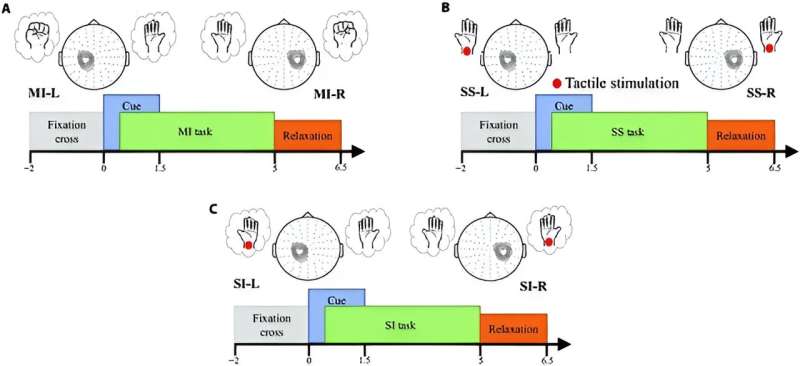This article has been reviewed according to Science X's editorial process and policies. Editors have highlighted the following attributes while ensuring the content's credibility:
fact-checked
peer-reviewed publication
proofread
Enhancing brain-computer interface performance through tactile and motor imagery

In a study recently published in the journal Cyborg and Bionic Systems, researchers from Zhejiang University have unveiled significant findings that could enhance brain-computer interface (BCI) technologies, marking a crucial step towards more intuitive neuroprosthetic control and advanced rehabilitation therapies.
The study, titled "Neural Correlates of Motor/Tactile Imagery and Tactile Sensation in a BCI paradigm: A High-Density EEG Source Imaging Study," employed high-density electroencephalogram (EEG) recordings to delve into the neural dynamics of motor and tactile imagery.
Brain-computer interfaces, devices that translate brain activity into commands for external software or hardware, have predominantly utilized motor imagery tasks where subjects imagine moving parts of their body without actual motion. This study expands on the BCI concept by integrating sensory imagery tasks, particularly focusing on tactile sensations, thereby providing new avenues for BCI applications.
The research team, led by Huan Wen and Lin Yao, conducted experiments involving eleven participants who were instructed to engage in both motor imagery (MI) and sensory imagery (SI) tasks. These tasks were designed to evoke brain responses from imagining motor actions and tactile sensations without physical stimuli. Using sophisticated EEG source imaging techniques, the study systematically examined the cortical activation differences and correlations between these tasks.
Key findings revealed that imagined tactile and motor tasks activate distinct regions within the sensorimotor cortex. While both tasks showed similar patterns in alpha bands, critical differences were noted in other frequency bands, indicating unique underlying neurophysiological processes. For instance, real sensory stimulation (SS) and imagined sensory tasks exhibited comparable activation patterns, suggesting potential strategies for training BCI systems.
This study is the first of its kind to use high-density EEG recordings to explore the intricate relationship between motor and tactile imagery. The researchers' approach has allowed for a detailed examination of the cortical sources of EEG signals, providing insights that were previously unattainable with traditional EEG methods.
The implications of these findings are vast. For one, they could significantly improve the accuracy and efficiency of BCIs, particularly in distinguishing between different types of imagery, which is crucial for the precise control of neuroprosthetics.
Moreover, the study paves the way for the development of new BCI designs that could include more diverse and complex commands, enhancing the interface's functionality.
In rehabilitation, these findings could revolutionize treatment protocols. Patients recovering from strokes or other motor impairments could benefit from tailored BCI therapies that harness both motor and tactile imagery, potentially accelerating the recovery process and improving outcomes.
The research also highlights the importance of sensory imagery in BCIs, an area that has received less attention compared to motor imagery. By demonstrating the feasibility and effectiveness of including sensory tasks in BCI frameworks, the study invites further exploration into multi-modal BCIs that could support more natural interactions with technology.
As we advance towards more integrated and responsive BCIs, the work of Wen, Yao, and their team provides a critical foundation for future innovations. Their study not only expands our understanding of the brain's imaging capabilities but also opens new pathways for enhancing human-computer interaction.
More information: Huan Wen et al, Neural Correlates of Motor/Tactile Imagery and Tactile Sensation in a BCI paradigm: A High-Density EEG Source Imaging Study, Cyborg and Bionic Systems (2024). DOI: 10.34133/cbsystems.0118

















